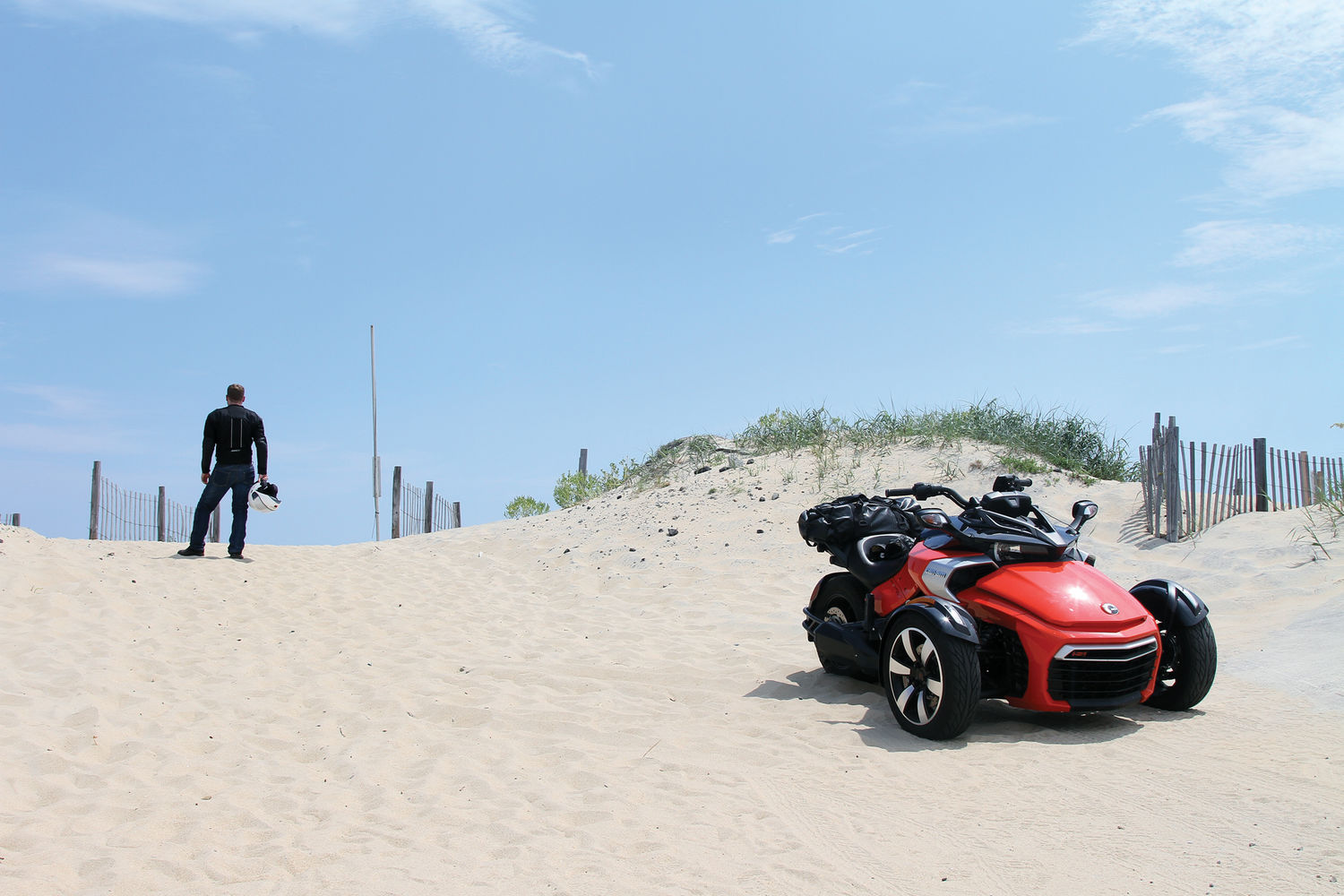North Carolina: A Triple Dose of the Coast

When most motorcyclists think about North Carolina, their minds instantly turn to the misty peaks of the Great Smoky Mountains, the undulating twists of the Tail of the Dragon, or the sweeping beauty of the Blue Ridge Parkway. Understandably so. But while the roads in the western part of the state are admittedly more curvy, the eastern half still has plenty to offer.
The Road to the Coast
During summer in North Carolina, each weekend sees a mass exodus from the inland cities toward the beaches. In a coffee shop on the east side of Greensboro, I’m about to join them. Outside the window, a bright orange 2015 Can-Am Spyder F3-S sits waiting. A quick run up US 29, a few turns, and I’m on US 158 heading toward the coast. It’s not long before I reach lush farmland. Fields of tobacco almost ready to be harvested appear at intervals on either side of the road. The Spyder and I are getting familiar with each other; I’m not used to shifting with paddles and only braking with my foot, but the learning curve isn’t as steep as I’d first feared.

It’s a perfect day for a ride. The Carolina sky is a clear blue with thin wisps of cloud drifting slowly high overhead. The air is hot, but the lack of a windscreen on the F3-S keeps me in a healthy breeze. A pleasant two-lane highway, 158 meanders across the state parallel to the Virginia border. This road will take me almost all the way to my first night’s refuge in Plymouth. The route runs through a long series of small towns with names like Yanceyville, Roxboro, Oxford, and Roanoke Rapids. I stop in Jackson to admire the Northampton County Courthouse, a lovely Greek Revival-style building in a town of just 500.
As I travel through the region North Carolinians refer to as “Down East” cotton gradually replaces tobacco as the local cash crop. In high summer, the fields are a brilliant green and the distinctive fluffy white fibers have yet to appear. My relaxing cruise continues as the Spyder’s raucous triple provides the soundtrack to my thoughts. In the tiny town of Winton, I finally bid adieu to 158 in favor of NC 45. Though the road is different the scenery remains pleasantly rural. The last few miles to Plymouth pass quickly and soon I’m pulling into the local Holiday Inn Express. I’m greeted by a whole row of high voltage battery charging stations for Tesla electric cars. In a town this size? How odd.

Learning to Fly … and Swim
Dawn comes and I’m already gone. I make a beeline for the coast on US 64. The first water I spot is the Alligator River followed quickly by the wildlife refuge named after it. A few miles later I cross the bridge onto Roanoke Island. I’m now on the chain of barrier islands known as North Carolina’s Outer Banks. This area has a vivid history filled with mystery, intrigue, and plenty of pirates. In 1587, Virginia Dare was born in a British colony on Roanoke Island, the first child of English descent born in the New World. What became of Virginia, her parents, or any of the other colonists, however, remains unknown. The mysterious disappearance of the Lost Colony has been the subject of debate and conjecture ever since.
Motorcycle & Gear
2015 Can-Am Spyder F3-S
Helmet: Shoei Neotec
Jacket: Joe Rocket Reactor 3.0 Mesh
Pants: Rokker Revolution Jeans
Boots: Stylmartin Indian
Gloves: Held Airstream II
The ride slows down as I roll into Manteo on the island’s north end. The town’s charming waterfront is calm and quiet on this Thursday morning. A man tries his luck fishing off a pier while an assortment of paddleboarders slowly maneuver around Shallowbag Bay. I park the Spyder and take a short stroll to admire the interesting architecture and a smattering of boats bobbing lazily in their berths.
Heading further from the mainland I navigate north through typical summer beach traffic toward a place with more recent historical significance—the sand dunes of Kill Devil Hills. Just over a century ago, brothers Wilbur and Orville Wright changed the world forever as their flying machine took to the air for the first time. The location of that momentous event is preserved at the Wright Brothers National Memorial just south of Kitty Hawk.

Seven dollars gets me in, and I pilot the Spyder around the loop road that encircles the 60-foot granite monument atop Kill Devil Hill. Carved into the stone face is the inscription, “In commemoration of the conquest of the air by the brothers Wilbur and Orville Wright. Conceived by genius. Achieved by dauntless resolution and unconquerable faith.” From the top of the hill, I look down on the wide field where the brothers conducted their aviation trials. Off to the side, some old wooden buildings replicate their hangar and workshops, giving visitors a feel for the Wrights’ incredible accomplishment. As an aviation buff it’s a treat to walk the ground where it all began.
